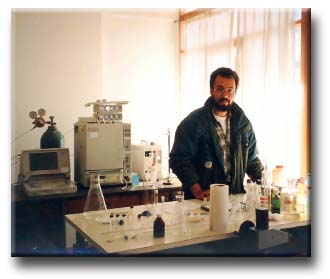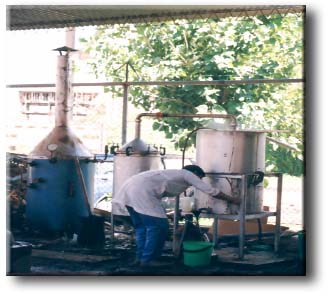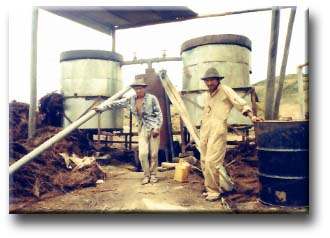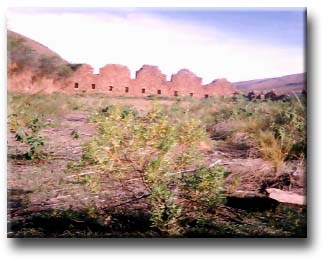Navigation
The "Centro de Tecnología Agroindustrial" program to transform the utilization of the Cochabamba region's vegetal resources
Cochabamba, a predominantly agricultural region, has a great vegetation diversity due to the different ecosystems present. However, Cochabamba does not have the means for transforming these resources. For this reason agricultural products are generally commercialized in a fresh state, which gives rise to all the problems usually associated with this type of commercialization: perishability, price fluctuation and a diminished ability to compete in the market.
The need for applied research on the utilization and transformation of the region's vegetal resources in order to obtain products with greater value added, led a group of researchers from the Faculty of Science and Technology at the “Universidad Mayor de San Simon (UMSS)” to create, in 1980, the “Programa Agroquímico” (at present the Centro de Tecnología Agroindustrial -CTA-).
Location:
Cochabamba, Bolivia
Problem Overview:
Rural poverty, inadequate resource utilization
Bolivia has a rich biodiversity that is not adequately utilized in spite of the extreme poverty prevalent in its rural areas. Within this context, the Centro de Tecnología Agroindustrial (CTA) plans to develop sustainable and economically productive opportunities in rural areas by the valuation of its vegetal resources helping to improve the quality of life of poor rural families while concurrently establishing a base for setting up an agroindustry, principally in the area of aromatics.
Background:
Cochabamba, a predominantly agricultural region, has a great vegetation diversity due to the different ecosystems present. However, Cochabamba does not have the means for transforming these resources. For this reason agricultural products are generally commercialized in a fresh state, which gives rise to all the problems usually associated with this type of commercialization: perishability, price fluctuation and a diminished ability to compete in the market.
The need for applied research on the utilization and transformation of the region's vegetal resources in order to obtain products with greater value added, led a group of researchers from the Faculty of Science and Technology at the “Universidad Mayor de San Simon (UMSS)” to create, in 1980, the “Programa Agroquímico” (at present the Centro de Tecnología Agroindustrial -CTA-). Faced with a lack of funds from San Simon to finance its activities, the Program requested support (both economic and human) from the “ex-Corporación de Desarrollo de Cochabamba (CORDECO)” in order to carry out the project. This support was established in an inter-institutional agreement between the UMSS and ex-CORDECO. The CTA functioned within this framework until 1995, the year in which CORDECO was closed down, due to restructuring at the national level. At this time, the CTA became completely housed under the UMSS.
The combined efforts of one institution dedicated to research (UMSS) and another dedicated to development (CORDECO) enabled the CTA to consolidate as an applied research unit focused on agroindustrial development. It specializes in the utilization and transformation of the region's vegetal resources in order to obtain products with greater value added, thus directly benefiting the rural small producers. In addition, it generates new sources of employment while providing the national industry with intermediate products of vegetal origin whose exportation brings foreign currency into the country.
In order to fulfill this goal, the CTA applies a self-developed methodology. It begins with the identification and characterization of the flora biodiversity in the region. It then uses applied research to assess the possibilities of the vegetation's transformation and commercialization. This process is organized into stages which consist of laboratory investigation and semi-commercial research in pilot production plants. This makes it possible to ascertain the feasibility of proposed agroindustrial projects, which are subsequently transferred to the interested parties.
 |
| Laboratory for essential oils analysis |
CTA's field of activity comprises the area of preservable foodstuffs, basic chemical products and natural products. The latter has received more attention, however, due to the promising nature of its products (extracts and essential oils) on the international market, the simplicity of the obtainment process, and the rich biodiversity in the region which has yet to be utilized.
Since 1983, as proposed in its goal and methodology, the CTA has been functioning in different rural communities in the department of Cochabamba, carrying out projects which have passed the stage of laboratory investigation and production on a pilot basis (such as the project for essential oils).
As a result of this project, numerous rural families are benefiting by:
a) their incursion into agroindustrial activity for which the value added generated stays in the community, benefiting its members and consequently improving the quality of life;
b) the diversification of agricultural production, thus reducing their income's vulnerability to fluctuations in the prices of traditional agricultural products due to climatic and/or economic factors; and
c) the reception of systematic training and technical assistance which has improved agricultural labor production.
Initially, the financing for the CTA's activities was based on support from the UMSS and CORDECO, as well as on the generation of its own resources which came from the sale of products and services. Thanks to the success obtained from the implementation of the rural extraction units and subsequently with other projects, the CTA has obtained financial support from international organizations which help research and development activities. These organizations include FONAMA (Fondo Nacional para el Medio Ambiente - Bolivia), NOVIB (Netherlands Organization for International Cooperative Development), GRETT (Group of Investigations and Technological Exchanges - France), ORSTOM (French Institute for Cooperative Development Research), and, principally, the IDRC (International Development Research Centre - Canada), which supports, at present, the search for new natural products in the flora of Cochabamba.
With local and international support, the CTA has been able to obtain important scientific equipment and to build over more than 1035 m2 including laboratories for analysis, process, biological essays and tissue culture as well as a greenhouse and area for pilot scale production. In addition, in the rural area there exists a laboratory and essays parcels and housing for agricultural technicians.
The department of Cochabamba, located in the center of Bolivia, has a diversity of climates, soils, vegetal coverage and physiographic characteristics, forming part of three large agro-ecological systems: valleys, high plateaus, and tropic low lands, all with a great vegetation diversity which is not adequately utilized. Due to increasing deforestation (for woodfuel in the valleys and high plateaus and for timber and with the purpose of enabling new agricultural areas in the tropics), some promising species are in danger of extinction, in many cases without any prior study of their use and under the risk of creating imbalances in the region's ecological systems.
In spite of this rich biodiversity, the farmers in the region basically cultivate traditional products (potatoes, corn, some vegetables and fruit), the majority of which have low productivity levels and are subject to large price fluctuations on the national market. In general, agriculture is carried out on a subsistence level due to the small farmland (the average landholding is one hectare per family) and the lack of water for irrigation. In this situation, rural families obtain a low income from the sale of their products, which is generally not sufficient to cover their basic subsistence needs. In general, they live in extreme poverty and with no production alternatives which would allow them to improve their income levels. The average per capita income of the rural families is around $500 U.S. per year, which is lower than the national average. This precarious economic situation is accompanied by deplorable social conditions. In the rural areas illiteracy reaches 40% and health attention is deficient, reaching only a minimum number of the population.
Faced with this reality, the Centro de Tecnología Agroindustrial (CTA--previously the Programa Agroquímico) has taken steps directed toward the valuation of the vegetal resources in the region in order to benefit the neediest rural population.
The Centro de Tecnología Agroindustrial is an applied research unit focussing on agroindustrial development. It was created in 1980, based on an inter-institutional agreement between the Universidad Mayor de San Simón (UMSS) and the ex Corporación de Desarrollo de Cochabamba (CORDECO), its purpose being to "contribute to the sustainable development of the department of Cochabamba with systematic studies and projects oriented towards the economic valuation and rational use of the region's vegetal resources”.
In order to accomplish these research and development activities, the CTA's methodology of action is to take on the challenge of adapting, specifying and generating technologies appropriate to the socio-economic situation in the region. With this in mind, the elaboration of projects includes stages of agricultural research and laboratory investigation together with semi-commercial research and production in pilot plants, in this way gathering the experimental background necessary for certifying the projects.
With the application of this methodology, results have been obtained in the identification and implementation of new agroindustrial projects, as well as in the generation of a technical-scientific base which is unique in Bolivia. News of its existence and success has reached beyond the national borders.
The field of operation encompasses three types of agroindustries:
a) preservable foodstuffs obtained by the application of specific methods to the preservation of the agricultural products;
b) basic chemical products which undergo physiochemical transformations and industrial fermentation; and
c) natural products which undergo processes of extraction, separation and purification of active components.
Of these three, the area which deserved more attention and which, at present, has a higher level of development, is the area of natural products (essential oils and extracts) due to technological, financial and marketing reasons.
 |
| Pilot scale unit for extraction of essential oils installed at CTA |
It must be pointed out that the implementation of CTA's projects consists of two phases: a rural level oriented towards the primary processing of the vegetation products whose activities fall under the responsibility of rural organizations, and an urban level in charge of the purification and refining of semi-processed materials from the rural areas. The urban stage is managed by technicians from the CTA, which operates at present in the Center's installations at the UMSS campus.
Thus, in 1983, the CTA initiated research on the obtainment of natural products in general and of essential oils specifically. For this, processes of steam extraction which were relatively simple and easily adaptable to the rural areas were used because they did not require sophisticated industrial technology. Each distillation unit includes extractors (from 1.5 cubic meters to 5 cubic meters), a steam generator, a condenser, and a separator. These elements are constructed locally at an approximate cost of 2000 to 6000 American dollars, depending on the size.
After passing the laboratory stage and installing a pilot unit for the extraction of essential oil of eucalyptus (Eucalyptus globulus) according to the adopted methodology, in 1985 the CTA installed the first rural unit for obtaining this oil in the community of Pairumani, 30 km. from the city of Cochabamba, taking advantage of existing eucalyptus forests in that area.
The ownership and operation of this rural extraction equipment is in the hands of a rural women cooperative of 30 members which, with the income generated, has managed to carry out other productive projects. Thanks to the guarantee which the extraction equipment represents, the cooperative has secured financial support for the purchase of assets.
 |
| A rural unit for the obtainment of essential oils |
At the same time, research was carried out on the use of lemon grass (Cymbopogon citratus), a project which, once the laboratory essays had been carried out, passed on to the pilot stage with the installation in 1987 of an extraction unit in the area of tropical Chapare. The distinguishing characteristic of this unit was that, in contrast to the eucalyptus tree project, lemon grass cultivation had to be introduced and promoted in the region. The production capacity of this unit is of 16 metric tons a year.
Progress has also been made in the production of essential oil of japanese mint. Its cultivation was introduced, and subsequently an extraction unit with a production capacity of 6.5 metric tons a year was installed in the tropical area of Chapare.
As a consequence of the success obtained and the experience accumulated, the project began to diversify into the research and the production of other essential oils. Thus, since 1990, research is being carried out for obtaining other essential oils. The utilization of introduced and native vegetal raw materials is considered. Some examples for the introduced species are: vetiver (Vetiveria zizanioides), citriodora eucalyptus (Eucalyptus citriodora) and palmarosa (Cymbopogon martini); there are also various native Andean species such as romerillo (Acanthostyles buniifoluis), molle (Schinus molle), thola (Baccharis dracunculifolia), and muña negra (Hedeoma mandoniana).
The native species are being used in their wild state. For this purpose, two small extraction units have been installed in areas where the vegetal material is produced.
 |
| Romerillo, a native species growing near Incallajta (Inca's Ruins) |
It must be pointed out that all the CTA's projects take into account the ecological aspects. For example, in the case of the native species, studies are conducted on their quantification, distribution, conservation and domestication. That is, while working on the valuation of the native vegetation biodiversity, the equilibrium of the ecological system is carefully considered.
Up to the present, the CTA, with financing from various institutions, which support rural and technological development, has installed various units for the extraction of essential oils in rural communities that showed interest in this productive activity. In the case of essential oil of eucalyptus, 11 rural extraction units have been installed, with a production capacity of 12 metric tons per year. There are two units for the extraction of lemon grass and mint, and another two units for the extraction of native species.
The responsibility for the production of essential oils is in the hands of the farmers organizations, whose members are trained by CTA technicians in the operation and maintenance of the extraction units.
The help which CTA gives to the farmers communities is not limited only to technical training but also begins with taking steps to obtain financing for the infrastructure and the extraction equipment to be installed in the rural community. It also assures the acquisition of the entire production of oils at prearranged prices by means of agreements between the rural production organizations and the CTA.
In addition to the development of the projects in rural areas, the technology for purification of the different essential oils has also been developed. This phase of the processing is carried out in installations of the CTA at the UMSS university campus. The products which are obtained comply with all quality requirements, and their commercialization has been a success on the national as well as international level.
At present, commercial agreements are in effect with companies in Japan, France and Germany for regular shipments of different quantities of essential oils (romerillo, thola, muña and others). Contracts also exist with national companies for the provision of eucaliptol and other essential oils. To a large degree, this has replaced the importation of these essential oils.
The CTA generates around $100,000 U.S. annually for the benefit of the region with the local and external commercialization of these essential oils,
Constraints:
Undoubtedly, one of the factors that limits the expansion of the rural essential oils agroindustry is the lack of financing which is needed to carry out research activities in order to identify new promising species (there is a lack of studies identifying and characterizing the species of the national flora), and to cover the costs of constructing rural extraction units with the basic infrastructure needed for their operation.
Because it is set up as an activity which is complementary to the traditional agricultural sector and is still not consolidated in the rural area, the production of essential oils suffers ups and downs, especially during the times when a big demand for agricultural labor exists. This has sometimes led to a failure to fulfill the agreed upon volumes of the product, thus creating a situation which damages the CTA's reputation for reliability and resulting in a loss of confidence, mainly on the part of companies outside the country.
Together with the previously mentioned fluctuations, the present low volume of production does not permit entering the international market on a solid basis because this market generally demands large volumes of production on a regular basis.
Implementation Status:
A base has been established for a rural agroindustry in the region with the initiation of the production of different essential oils (eucalyptus, lemon grass, japanese mint, black muña, romerillo, molle, thola and others). Fifteen units for the extraction of essential oils have been installed in different rural areas in the department of Cochabamba, with the associated benefits for farmers and national industry.
The CTA, in spite of being a unit for applied research, carries out direct activities to promote sustainable rural development and to benefit the most needy sector of the rural population in Cochabamba.
Approximately 450 farmer families in the different rural communities have benefited from the implementation of the units for the extraction of essential oils. In addition to continuing with their traditional agricultural activities, they have become active in the agroindustrial sector of aromatics, thereby generating close to 100,000 U.S. dollars annually in supplementary income, a very significant amount if we compare it with the income they obtain from the sale of their traditional agricultural products.
Likewise, new jobs have been generated with the diversification of productive activities, in addition to allowing better distribution of the productive time of agricultural labor, which, in the majority of these cases is underused.
The improvement in the quality of life of the families who have benefited from the project for essential oils is clearly evident.
In addition to the direct economic and social benefits for the rural families involved in the agroindustry of aromatics, some native Andean species, which had previously no economic utility, have been valorized. In other cases, the species were being used only as domestic fuel, producing an ecological imbalance in the concerned zones.
Due to the nature of its activities as well as to its infrastructure and the equipment it possesses for research and development, the Centro de Tecnología Agroindustrial constitutes one of the principal institutions in this field in the country and has received recognition on a national level, such as the “Premio Nacional al Mérito Científico” (National Award for Scientific Merit) awarded by the National Academy of Sciences of Bolivia.
Follow-up Strategy:
At present, with the financial support of IDRC (International Development Research Centre), the aromatic and insecticidal properties of new native species are being evaluated to assess their potential as commercially promising products (essential oils or extracts). Samples of these new products are sent to potential clients in the international market for natural products and, based on the degree of success obtained, work will continue on the future stages, according to the methodology adopted by the CTA in these cases.
Submitted by:
Centro de Tecnología Agroindustrial -CTA- (before - Programa Agroquímico –PAGQ-)
Eng. Eduardo Zambrana Montán
centrote@pino.cbb.entelnet.bo, pagq@comteco.entelnet.bo
Oquendo y Sucre Campus Universitario de Las Cuadras - Universidad Mayor de San Simón Cochabamba - BOLIVIA
591- 04 - 233648 ; 591- 04 - 232548
Organizations:
IDRC - International Development Research Centre - Canada
CTA - Agroindustrial Technology Centre - Bolivia
Organization Reference People:
Pierre Zaya, P. Eng., Dr., Senior Scientist - IDRC
Eduardo Zambrana, Eng., Director CTA
Organization Telephone & Fax Numbers:
613 – 567 - 7749, 613 – 236 - 6163, CANADA
591 – 42 - 33648, 591 – 42 - 32548, BOLIVIA
Organization Addresses:
Oquendo y Sucre (Campus UMSS)
Cochabamba
PO Box 6225
BOLIVIA
Pzaya@idrc.ca
centrote@pino.cbb.entelnet.bo
pagq@comteco.entelnet.bo
Information Date: 1999-04-26
Information Source: Centro de Tecnología Agroindustrial -CTA- (previously Programa Agroquímico)
- Login to post comments

Search
Latest articles
Agriculture
- World Water Week: Healthy ecosystems essential to human health: from coronavirus to malnutrition Online session Wednesday 24 August 17:00-18:20
- World Water Week: Healthy ecosystems essential to human health: from coronavirus to malnutrition Online session Wednesday 24 August 17:00-18:20
Air Pollution
- "Water and Sanitation-Related Diseases and the Changing Environment: Challenges, Interventions, and Preventive Measures" Volume 2 Is Now Available
- Global Innovation Exchange Co-Created by Horizon International, USAID, Bill and Melinda Gates Foundation and Others
Biodiversity
- It is time for international mobilization against climate change
- World Water Week: Healthy ecosystems essential to human health: from coronavirus to malnutrition Online session Wednesday 24 August 17:00-18:20
Desertification
- World Water Week: Healthy ecosystems essential to human health: from coronavirus to malnutrition Online session Wednesday 24 August 17:00-18:20
- UN Food Systems Summit Receives Over 1,200 Ideas to Help Meet Sustainable Development Goals
Endangered Species
- Mangrove Action Project Collaborates to Restore and Preserve Mangrove Ecosystems
- Coral Research in Palau offers a “Glimmer of Hope”
Energy
- Global Innovation Exchange Co-Created by Horizon International, USAID, Bill and Melinda Gates Foundation and Others
- Wildlife Preservation in Southeast Nova Scotia
Exhibits
- Global Innovation Exchange Co-Created by Horizon International, USAID, Bill and Melinda Gates Foundation and Others
- Coral Reefs
Forests
- NASA Satellites Reveal Major Shifts in Global Freshwater Updated June 2020
- Global Innovation Exchange Co-Created by Horizon International, USAID, Bill and Melinda Gates Foundation and Others
Global Climate Change
- It is time for international mobilization against climate change
- It is time for international mobilization against climate change
Global Health
- World Water Week: Healthy ecosystems essential to human health: from coronavirus to malnutrition Online session Wednesday 24 August 17:00-18:20
- More than 400 schoolgirls, family and teachers rescued from Afghanistan by small coalition
Industry
- "Water and Sanitation-Related Diseases and the Changing Environment: Challenges, Interventions, and Preventive Measures" Volume 2 Is Now Available
- Global Innovation Exchange Co-Created by Horizon International, USAID, Bill and Melinda Gates Foundation and Others
Natural Disaster Relief
- STOP ATTACKS ON HEALTH CARE IN UKRAINE
- Global Innovation Exchange Co-Created by Horizon International, USAID, Bill and Melinda Gates Foundation and Others
News and Special Reports
- World Water Week: Healthy ecosystems essential to human health: from coronavirus to malnutrition Online session Wednesday 24 August 17:00-18:20
- STOP ATTACKS ON HEALTH CARE IN UKRAINE
Oceans, Coral Reefs
- World Water Week: Healthy ecosystems essential to human health: from coronavirus to malnutrition Online session Wednesday 24 August 17:00-18:20
- Mangrove Action Project Collaborates to Restore and Preserve Mangrove Ecosystems
Pollution
- Zakaria Ouedraogo of Burkina Faso Produces Film “Nzoue Fiyen: Water Not Drinkable”
- "Water and Sanitation-Related Diseases and the Changing Environment: Challenges, Interventions, and Preventive Measures" Volume 2 Is Now Available
Population
- "Water and Sanitation-Related Diseases and the Changing Environment: Challenges, Interventions, and Preventive Measures" Volume 2 Is Now Available
- "Water and Sanitation-Related Diseases and the Changing Environment: Challenges, Interventions, and Preventive Measures" Volume 2 Is Now Available
Public Health
- Honouring the visionary behind India’s sanitation revolution
- Honouring the visionary behind India’s sanitation revolution
Rivers
- World Water Week: Healthy ecosystems essential to human health: from coronavirus to malnutrition Online session Wednesday 24 August 17:00-18:20
- Mangrove Action Project Collaborates to Restore and Preserve Mangrove Ecosystems
Sanitation
- Honouring the visionary behind India’s sanitation revolution
- Honouring the visionary behind India’s sanitation revolution
Toxic Chemicals
- "Water and Sanitation-Related Diseases and the Changing Environment: Challenges, Interventions, and Preventive Measures" Volume 2 Is Now Available
- Actions to Prevent Polluted Drinking Water in the United States
Transportation
- "Water and Sanitation-Related Diseases and the Changing Environment: Challenges, Interventions, and Preventive Measures" Volume 2 Is Now Available
- Urbanization Provides Opportunities for Transition to a Green Economy, Says New Report
Waste Management
- Honouring the visionary behind India’s sanitation revolution
- Honouring the visionary behind India’s sanitation revolution
Water
- Honouring the visionary behind India’s sanitation revolution
- Honouring the visionary behind India’s sanitation revolution
Water and Sanitation
- Honouring the visionary behind India’s sanitation revolution
- Honouring the visionary behind India’s sanitation revolution

